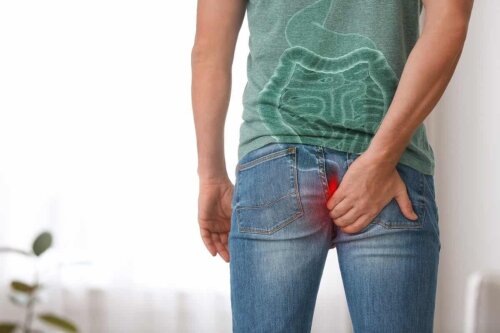Tying a Hemorrhoid With an Elastic Band: What's the Procedure?

Tying a hemorrhoid with an elastic band is the most efficient non-surgical treatment for treating internal hemorrhoids. Even though it offers good results over the long term, many people don’t choose it because it’s a painful procedure.
Hemorrhoids are inflamed blood vessels in the lower rectum and anus. Although they’re not life-threatening, they can be quite annoying for those who suffer from them. They usually cause pain, burning. general unease, and bleeding.
When home remedies don’t alleviate the issue, tying hemorrhoids with an elastic band is a promising alternative. This can help the patient avoid surgery, which, although offers better results over the long term, is more expensive and has more risk of complications.
When is tying a hemorrhoid with an elastic band necessary?

It’s very common that at the start, people treat hemorrhoids with home remedies. In general, this is with Sitz baths, cold compresses, or topical creams. However, sometimes these don’t eliminate the problem. The pain, itching, and bleeding can become a common irritation.
Tying a hemorrhoid with an elastic band may is a suitable treatment for those who have internal hemorrhoids that don’t respond to home treatments. These types of hemorrhoids are located inside the rectum, rather than under the skin near the anus.
So that the tying of the hemorrhoid works, there needs to be enough tissue so that specialists can use a band. The doctor should explore the area and determine whether this treatment is possible. Specialists advise against this for grade IV hemorrhoids; by which we mean those with a permanent prolapse or that are always outside of the body.
Previous preparation
Previous preparation for a hemarrhoid tying is simple. You just need to talk to your doctor about the medication and supplements that you’re taking, including over-the-counter medication. They will tell you what you should stop taking.
If the doctor needs to administer anesthesia, they’ll likely tell you to eat and drink between 6 and 12 hours before the procedure. In some cases, you may also have some blood tests.
If you have this procedure, you’ll need to have someone with you who can drive you home. Similarly, it’s important to be able to rely on someone to support you during the days following the procedure to avoid you over-exerting yourself as this could cause complications.
Also read: What Thrombosed Hemorrhoids Are and How to Identify Them
What’s the procedure?
Tying a hemorrhoid with an elastic band is an outpatient procedure that a doctor can do in their office. It begins with the doctor administering a local anesthetic. If the hemorrhoids are very painful or the doctor needs to use a few elastic bands, you may need a general anesthetic.
This procedure aims to tie elastic bands around the base of the hemorrhoid to cut off the blood flow. For that reason, the doctor will introduce a small tube with a light at the end into the rectum. This device is called an anoscope.
After this, the doctor will introduce another tool called a linker through the anoscope. This allows them to put the elastic band around the base of each hemorrhoid. If there’s one or two, you’ll be under local anesthetic and it should only take a few minutes.
If you have more or they’re really painful, it’s common for a doctor to do this procedure in a hospital with a general anesthetic. In these cases, the process will take more time.
Recuperation and projection
You can expect the hemorrhoids to shrink and die once you have cut the blood flow off with elastic bands. After a week, in the majority of cases, these should drop from the body themselves.
After the procedure, you’ll likely experience some pain for 24 to 48 hours. You can treat this with over-the-counter painkillers and with other steps like Sitz baths with warm water. It’s not a good idea to take aspirin or non-steroidal anti-inflammatory medication or NSAIDs for four to five days.
You may also experience some irritations for a few days, such as gas, constipation, swelling, and abdominal pain. Some people can resume their daily activities almost immediately and others need one or two days of rest. In any case, you shouldn’t lift heavy objects or overexert yourself.
Don’t miss: 9 Natural Remedies that May Help Treat Hemorrhoids
Tying a hemorrhoid with an elastic band: Possible risks and complications

In general, tying a hemorrhoid is a safe procedure. It’s uncommon for it to cause complications. However, in a few cases, there’s a possibility that you may experience one or several of the following difficulties:
- Severe pain that doesn’t respond to medication or other measures. This usually happens because the bands are too close to the pain receptors in the anal canal.
- Bleeding from the anus
- Urine retention or inability to urinate
- Infection to the anal zone
- Fever and chills
- Recurrence of hemorrhoids
Tying a hemorrhoid with an elastic band offers a quick recovery time
If tying the hemorrhoid doesn’t work, your doctor may recommend some minimally invasive surgical procedure like electrotherapy or electrocoagulation. The last alternative option is resulting to surgical removal.
Even though tying a hemorrhoid with an elastic band can be painful and uncomfortable to start, it’s worth considering as a treatment option. The quick recovery time and its high efficiency are great motivations for it.
All cited sources were thoroughly reviewed by our team to ensure their quality, reliability, currency, and validity. The bibliography of this article was considered reliable and of academic or scientific accuracy.
- Cabello Magûes, P., & Martínez Ordoñez, P. A. (2017). Principales complicaciones posoperatorias con el uso de la anestesia general. Medisan, 21(10), 3084-3089.
- Vitale, M., Parellada, C., & Poole, J. (2001). Estudio comparativo entre ligadura con banda elástica y escleroterapia en el tratamiento de hemorroides internas. Rev. guatemalteca cir, 27-30.
- Seminario, R. A. C., Calle, Á. R. T., & Valverde, R. E. U. (2018). Efectividad de la técnica ligadura con banda elástica y Milligan-Morgan en el tratamiento de hemorroides. HAMPI RUNA, 16(2), 201-224.
This text is provided for informational purposes only and does not replace consultation with a professional. If in doubt, consult your specialist.








